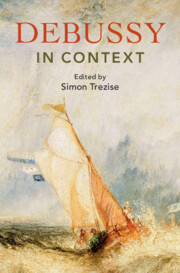Book contents
- Debussy in Context
- Composers in Context
- Debussy in Context
- Copyright page
- Dedication
- Contents
- Illustrations
- Contributors
- Preface
- Notes on the Text
- Abbreviations
- Part I Paris: City, Politics, and Society
- Part II The Arts
- Part III People and Milieu
- Part IV Musical Life: Infrastructure and Earning a Living
- Part V The Music of Debussy’s Time
- Chapter 23 Composing for Opera and Theatre outside Established Genres
- Chapter 24 Ballet and Dance
- Chapter 25 Orchestral Music and Symphonic Traditions
- Chapter 26 Chamber Music
- Chapter 27 Song and Choral Music
- Chapter 28 The Piano
- Part VI Performers, Reception, and Posterity
- Recommendations for Further Reading and Research
- Index
Chapter 24 - Ballet and Dance
from Part V - The Music of Debussy’s Time
Published online by Cambridge University Press: 23 May 2024
- Debussy in Context
- Composers in Context
- Debussy in Context
- Copyright page
- Dedication
- Contents
- Illustrations
- Contributors
- Preface
- Notes on the Text
- Abbreviations
- Part I Paris: City, Politics, and Society
- Part II The Arts
- Part III People and Milieu
- Part IV Musical Life: Infrastructure and Earning a Living
- Part V The Music of Debussy’s Time
- Chapter 23 Composing for Opera and Theatre outside Established Genres
- Chapter 24 Ballet and Dance
- Chapter 25 Orchestral Music and Symphonic Traditions
- Chapter 26 Chamber Music
- Chapter 27 Song and Choral Music
- Chapter 28 The Piano
- Part VI Performers, Reception, and Posterity
- Recommendations for Further Reading and Research
- Index
Summary
Marcel Dietschy declared, early in his centenary biography La Passion de Claude Debussy, that there was a woman at every crossroads in Debussy’s life. Years later, William Ashbrook and Margaret Cobb chose to omit many of Dietschy’s ‘effusive personal comments’ about the composer’s love life from their updated, more ‘objective’ 1990 translation. In trying to navigate the avenues by which myriad ideas and cultures of dance intersect with that context, a slight reframing of Dietschy’s romantic conceit suggests a useful guiding thread. At a time when musicologists seek to complicate individualistic focus on ‘great men’ with attention to the countless Others who aided their practice, this chapter notes the central role various foreign women played, directly and indirectly, in the dance worlds that impinged upon this compositional œuvre. From the outset, it frames the œuvre against the historical evolution of several overlapping worlds of dance, beginning with Debussy’s first publication, in Moscow in 1880, which was a four-hand arrangement of three characteristic dances from Pyotr Ilyich Tchaikovsky’s first ballet, Le Lac des cygnes (1875–6) – a direct emergence from his youthful sojourns at the piano with Tchaikovksy’s patron Nadezhda von Meck. A few short decades after this, a last work written expressly for dance, the unfinished children’s ballet La Boîte à joujoux of 1913, serves as an illustration of the new possibilities that had by then emerged for the art form.
- Type
- Chapter
- Information
- Debussy in Context , pp. 220 - 229Publisher: Cambridge University PressPrint publication year: 2024

